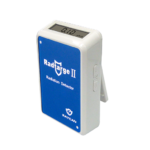Health physicist Neill Stanford of Stanford Dosimetry released a presentation examining the differences between electronic and passive dosimetry. Passive dosimeters such as film badge dosimeters and thermoluminescent dosimeters (TLDs) are typically used as the primary dosimeter to record the dose of legal record. With no immediate readouts or alarms, passive dosimeters must be sent to an accredited laboratory for processing in order to procure the dose of record. Electronic dosimeters not only provide immediate readouts and alarm options but also data logging, data upload, and access control. Real-time detection and measurement make electronic dosimeters especially useful in controlling doses, enabling them to be used as secondary dosimeters for dose control and backup.
In addition to the aforementioned features, X-Z LAB’s RadTarge II | Electronic Personal Dosimeter (EPD) can distinguish and account for background radiation. Its use of a silicon photomultiplier (SiPM) ensures no interference from a magnetic field as well, allowing for accurate and reliable readings.
